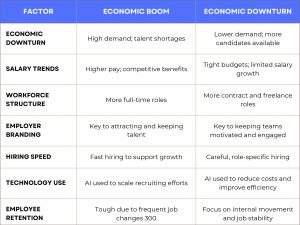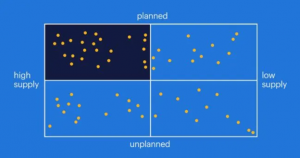Introduction: How 2025’s Economy is Reshaping Talent Acquisition
The hiring landscape has entered a new era of transformation, driven by rapid economic shifts, technological advancements, and evolving business priorities. The global economy in 2025 looks vastly different from just a few years ago, demanding more agile, data-driven, and AI-powered hiring solutions. Companies are no longer just reacting to economic trends—they’re strategically aligning talent acquisition with market fluctuations to stay ahead.
In booming economies, businesses struggle with talent shortages, rising salaries, and fierce hiring competition. In downturns, hiring freezes and budget constraints force companies to rethink how they source and retain critical talent efficiently. The rise of gig work and hybrid models has also led to a more fluid, on-demand workforce, requiring businesses to embrace adaptive workforce planning.
As companies navigate this hiring complexity, AI-powered workforce solutions like Velocity MSP provide the agility and intelligence needed to stay competitive. Predictive hiring insights, automated workforce planning, and AI-driven recruitment help organizations anticipate hiring needs, optimize workforce procurement, and reduce time-to-fill. The future of talent acquisition isn’t just about keeping up—it’s about staying ahead with data-driven decisions and technology-driven efficiency.
Now, let’s explore how economic shifts in 2025 are reshaping hiring trends and what businesses can do to build a resilient, future-ready workforce.
Table of Contents
- Introduction: The Impact of Economic Shifts on Hiring
- Understanding Economic Booms and Downturns
- Hiring Strategies During an Economic Downturn
- Talent Acquisition in an Economic Boom
- The Role of AI & Workforce Analytics in Talent Strategy
- The Future of Workforce Resilience – Why AI-Driven Hiring Matters
- Final Thoughts: Adapt Today for a Stronger Workforce Tomorrow
The New Economic Landscape: How Hiring is Changing in 2025
The hiring landscape in 2025 looks vastly different from previous years. Businesses are navigating economic fluctuations shaped by inflationary pressures, evolving labor markets, and rapid advancements in AI and automation. Unlike past cycles, workforce trends are no longer dictated solely by market demand but by a complex mix of technological innovation, shifting employee expectations, and global workforce accessibility.
Key changes impacting hiring in 2025:
- Skills-Based Hiring Over Degrees – Companies are prioritizing skills and competencies rather than traditional credentials, focusing on adaptability and job function evolution.
- Rise of Hybrid & Remote Workforces – Employers have access to wider talent pools, but managing global teams requires more sophisticated workforce solutions.
- Demand for Workforce Agility – Businesses facing economic uncertainty are relying more on contingent workers, contract roles, and AI-driven hiring models.
- Hiring Competition in Growth Sectors – Industries like AI, healthcare, and logistics are aggressively competing for a limited pool of specialized professionals, driving up wages and hiring costs.
Amid these shifts, businesses require strategic workforce solutions to remain agile. Velocity MSP’s AI-driven workforce solutions help organizations adapt by:
- Predicting hiring needs based on real-time market insights and demand forecasting.
- Optimizing labor costs through intelligent workforce planning.
- Automating talent sourcing to reduce time-to-hire and improve workforce efficiency.
Economic Booms vs. Downturns: How Hiring Strategies Shift
Economic cycles have always influenced hiring trends, but in 2025, the impact is even more pronounced due to rapid technological advancements, shifting workforce expectations, and global economic transformations. Businesses that understand these fluctuations can develop resilient hiring strategies to sustain growth and maintain a competitive edge.
Hiring in an Economic Boom: Growth, Competition, and Retention Challenges
During economic booms, businesses experience heightened demand for products and services, leading to job creation and fierce competition for skilled talent. While opportunities abound, companies face challenges in securing top professionals and managing rising labor costs.
Key Hiring Trends in a Boom:
- Intensified competition for skilled professionals – Businesses must offer competitive salaries and compelling employer branding to attract talent.
- Rising compensation expectations – Employees expect higher wages, performance bonuses, and workplace perks.
- Shift toward AI-driven recruitment – Automated sourcing and screening tools help companies hire at scale while reducing time-to-fill.
- Focus on long-term workforce sustainability – Companies invest in future-proofing their workforce through training and development.
How Velocity MSP Helps:
Velocity MSP’s AI-powered workforce solutions support businesses during high-growth phases by:
- Automating talent sourcing and screening, reducing time-to-hire while maintaining quality.
- Leveraging predictive analytics to forecast hiring trends and proactively plan workforce expansion.
- Enhancing candidate engagement through AI-driven personalized interactions, reducing offer rejections.
Hiring in an Economic Downturn: Cost Efficiency and Workforce Resilience
Economic slowdowns create a cautious hiring environment where companies focus on sustainability rather than expansion. However, downturns also present unique opportunities as top-tier talent becomes more available due to layoffs and restructuring.
Key Hiring Trends in a Downturn:
- Selective hiring with an emphasis on critical roles – Companies prioritize roles that directly contribute to business stability and recovery.
- Increased reliance on contingent and gig workers – Flexible staffing solutions help companies navigate uncertainty.
- Cost-conscious workforce planning – Businesses implement AI-powered hiring tools to optimize expenses.
- Greater focus on retention and internal mobility – Instead of external hires, companies upskill existing employees to fill emerging roles.
How Velocity MSP Helps:
Velocity MSP’s technology-driven solutions assist companies during economic slowdowns by:
- Enhancing cost efficiency with AI-driven hiring automation, reducing recruitment overhead.
- Providing on-demand access to a flexible workforce, allowing businesses to scale efficiently.
- Offering AI-powered workforce analytics to help companies make data-driven hiring decisions and optimize talent utilization.
Smart Hiring Strategies for Economic Uncertainty
Economic uncertainty demands strategic, agile, and data-driven hiring approaches. Companies that adjust their talent acquisition strategies based on market conditions can maintain workforce stability while seizing opportunities for growth. Whether navigating an economic boom or downturn, businesses must strike a balance between cost efficiency and talent retention.
Strategies for Hiring During an Economic Boom
During high-growth periods, companies must scale their workforce rapidly while standing out in a competitive job market. To attract top talent and retain employees, organizations must prioritize employer branding, competitive compensation, and long-term workforce planning.
- Strengthen Employer Branding to Attract Top Talent
- Build a strong online presence and highlight company culture, career growth opportunities, and employee success stories.
- Leverage AI-powered recruitment marketing to target passive job seekers with personalized outreach.
- Position the company as an industry leader through thought leadership, employee testimonials, and digital content.
- Accelerate Hiring with AI-Driven Recruitment
- Use AI-powered resume screening and automated candidate engagement to speed up the hiring process.
- Implement predictive hiring analytics to anticipate talent shortages and proactively source candidates.
- Optimize job descriptions and postings with AI to attract the right talent while minimizing hiring bias.
- Invest in Retention and Upskilling Programs
- Prioritize career development programs to reduce employee turnover and improve engagement.
- Offer internal mobility options to retain high-performing employees looking for growth opportunities.
- Leverage AI-driven learning platforms to provide personalized upskilling and training paths.
How Velocity MSP Supports Hiring in a Boom:
- AI-powered hiring automation reduces time-to-hire while maintaining quality.
- Predictive workforce planning tools enable businesses to forecast hiring needs and proactively build talent pipelines.
- AI-driven engagement strategies keep candidates connected throughout the hiring process, minimizing offer drop-offs.
Strategies for Hiring During an Economic Downturn
When the economy slows, businesses must adopt a cost-conscious hiring approach while ensuring they retain key talent. Rather than halting hiring completely; organizations can use AI and automation to maintain agility, reduce overhead, and enhance workforce resilience.
- Optimize Hiring Costs with AI-Powered Recruitment
- Leverage AI to automate screening, interviewing, and onboarding, cutting recruitment expenses.
- Utilize AI-driven talent pooling to create a pipeline of ready-to-hire candidates for critical roles.
- Reduce reliance on expensive third-party recruiters by using AI-powered sourcing solutions.
- Prioritize Workforce Flexibility with Contingent Hiring
- Expand the use of contract workers, freelancers, and gig workers to maintain agility without long-term commitments.
- Use AI-powered vendor management solutions like Velocity MSP’s VMAAS to streamline contingent workforce management.
- Implement direct sourcing strategies to reduce dependency on staffing agencies and minimize recruitment costs.
- Focus on Internal Mobility and Retention
- Shift hiring strategies toward internal promotions, reskilling, and redeployment of existing employees.
- Implement AI-driven workforce analytics to identify high-potential employees for leadership and critical roles.
- Offer structured career development programs to enhance employee loyalty and job satisfaction.
How Velocity MSP Supports Hiring in a Downturn:
- AI-driven cost optimization tools help businesses reduce recruitment expenses while maintaining hiring efficiency.
- On-demand workforce solutions provide companies with scalable, flexible talent options.
- AI-powered workforce analytics enable strategic workforce planning and talent retention efforts.
By adopting these smart hiring strategies, businesses can stay competitive and resilient regardless of economic conditions. In the next section, we’ll explore how Velocity MSP’s AI-powered solutions help companies navigate the complexities of workforce management in a changing economic landscape.
How Velocity MSP Powers Agile Workforce Strategies
In an era where economic shifts dictate business agility, organizations need AI-driven solutions to optimize workforce management. Velocity MSP helps businesses stay ahead by leveraging advanced automation, predictive analytics, and strategic workforce planning. Whether facing talent shortages, market fluctuations, or cost constraints, Velocity MSP ensures seamless hiring, retention, and vendor management.
AI-Driven Workforce Planning for Proactive Hiring
Traditional workforce planning often relies on historical data, making it difficult to predict future hiring needs. Velocity MSP’s AI-powered predictive hiring analytics transforms this approach by:
- Forecasting talent demand: AI analyzes industry trends, internal workforce data, and external economic indicators to predict hiring needs.
- Identifying skill gaps: Businesses can proactively upskill or reskill employees before shortages impact productivity.
- Optimizing hiring costs: AI helps companies allocate budgets efficiently, reducing unnecessary hiring expenses.
Enhancing Contingent Workforce Management with VMAAS
A flexible workforce is essential in uncertain economic conditions. Velocity MSP’s Vendor Management as a Service (VMAAS) provides businesses with:
- Real-time visibility into vendor performance: Companies can track fulfillment rates, contract compliance, and workforce availability in one centralized dashboard.
- Automated compliance tracking: AI ensures adherence to labor laws, preventing costly violations.
- Streamlined supplier management: Businesses can optimize their staffing suppliers, improving efficiency and cost-effectiveness.
Reducing Hiring Costs with AI-Powered Direct Sourcing
Relying on traditional staffing agencies can be costly, especially during economic downturns. Velocity MSP’s AI-driven direct sourcing solutions help businesses:
- Eliminate middleman fees by leveraging AI to connect directly with pre-vetted candidates.
- Improve hiring speed through automated candidate matching and real-time engagement.
- Enhance quality-of-hire by using AI-driven assessments to identify the best-fit talent.
Personalized Employee Retention Strategies
Retaining top talent is as crucial as attracting new employees. Velocity MSP enables companies to:
- Predict turnover risks by analyzing employee engagement, performance trends, and satisfaction levels.
- Offer personalized career growth plans using AI-powered learning recommendations.
- Enhance workforce well-being by implementing targeted retention strategies based on predictive workforce analytics.
Real-Time Workforce Analytics for Smarter Decisions
Velocity MSP integrates real-time workforce analytics, allowing businesses to:
- Monitor hiring performance and adjust strategies based on data-driven insights.
- Analyze workforce productivity trends to improve operational efficiency.
- Make agile business decisions with AI-powered forecasting and risk assessment.
The Future of Workforce Resilience – Why AI-Driven Hiring Matters
As global economies continue to shift, businesses that fail to modernize their workforce strategies will struggle to compete. The future of hiring is no longer about reactive recruitment—it’s about strategic workforce resilience powered by AI-driven insights, automation, and predictive workforce planning.
Why AI-Driven Hiring is the Key to Workforce Resilience
Companies that leverage AI and automation in their talent acquisition and workforce management strategies gain:
- Faster hiring cycles: AI reduces time-to-hire by automating screening, shortlisting, and candidate engagement.
- Reduced hiring costs: Predictive analytics optimize recruitment budgets by identifying the most cost-effective hiring channels.
- Enhanced talent quality: AI ensures better job-candidate matches based on skills, experience, and cultural fit.
- Proactive workforce planning: Instead of reacting to market fluctuations, businesses can forecast hiring needs and prevent talent shortages.
- Improved compliance and risk management: AI-powered hiring ensures adherence to labor laws, reducing legal risks and workforce misclassification.
The Future Workforce Model: AI-Integrated, Data-Driven, and Agile
The traditional workforce model—reliant on manual hiring, fragmented data, and outdated processes—is no longer sustainable. The next evolution of hiring demands:
Businesses that embrace AI-powered hiring and workforce analytics will gain a competitive advantage, ensuring workforce resilience, cost-efficiency, and adaptability in a constantly changing economy.
Velocity MSP – Your Partner in Future-Ready Hiring
Velocity MSP is at the forefront of AI-driven workforce transformation, offering businesses:
- Predictive workforce analytics to anticipate hiring needs and skill gaps.
- Automated hiring solutions to streamline recruitment and reduce costs.
- AI-powered compliance monitoring to eliminate hiring risks.
- Direct sourcing capabilities to connect businesses with top-tier talent without middleman fees.
As economic fluctuations continue, Velocity MSP empowers businesses to build a workforce that is not only adaptable but also future-proof.
Final Thoughts: Adapt Today for a Stronger Workforce Tomorrow
The hiring landscape is evolving, and businesses that embrace AI-driven workforce strategies will thrive in uncertain markets. Economic shifts can either be a challenge or an opportunity—the key lies in leveraging data, automation, and AI to build a resilient, agile, and future-ready workforce.
With Velocity MSP, companies can stay ahead of market changes, optimize hiring strategies, and build a workforce that fuels long-term growth.
Are you ready to future-proof your workforce? Get in touch with Velocity MSP today and start building a smarter, more adaptive hiring strategy.
FAQs
- How does economic uncertainty impact hiring trends?
Economic fluctuations influence hiring strategies, with downturns leading to budget constraints and cautious hiring, while booms create fierce competition for top talent.
- What role does AI play in modern hiring strategies?
AI enhances recruitment by automating screening, predicting workforce needs, improving candidate-job matching, and reducing hiring costs through data-driven insights.
- Why is a flexible workforce model important during economic shifts?
A mix of full-time employees, contract workers, and AI-driven automation allows businesses to scale up or down quickly without disrupting operations or increasing long-term costs.
- How can businesses attract top talent during a hiring boom?
Companies need to strengthen employer branding, streamline hiring processes, leverage AI-driven recruitment tools, and offer competitive compensation and career growth opportunities.
- How does Velocity MSP help businesses future-proof hire strategies?
Velocity MSP provides AI-powered workforce analytics, direct sourcing solutions, automated compliance tracking, and predictive hiring insights to optimize recruitment in any economic climate.









